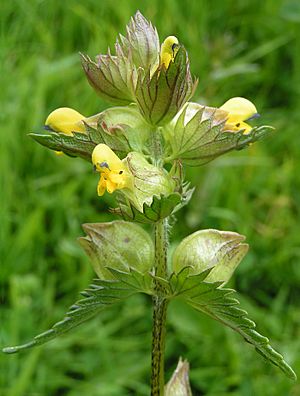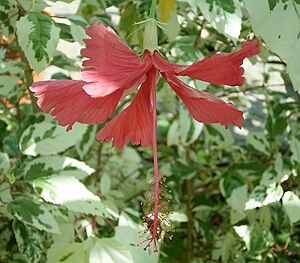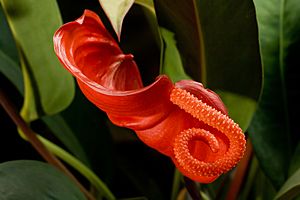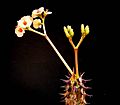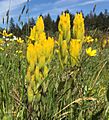Bract facts for kids
In the world of plants, a bract is a special kind of leaf. You usually find bracts near a flower or a group of flowers. Bracts often look different from regular leaves. They might be smaller, bigger, or have a different color, shape, or feel. They also look different from the flower parts like petals or sepals.
Contents
Different Kinds of Bracts
Some bracts are very bright and colorful. They can look like flower petals! These colorful bracts help attract insects like bees. The insects then help the plant make seeds.
Colorful Bracts
A great example of colorful bracts is the Poinsettia. The big red "petals" of a poinsettia are actually bracts. The real flowers are tiny and in the middle. Another plant with bright bracts is Bougainvillea. It has large, colorful bracts around its small, plain flowers.
Bracts in Grasses
Grasses also have bracts. Each tiny grass flower is wrapped in two papery bracts. A group of these flowers has another pair of bracts at its base. These are called glumes. When farmers harvest grains like wheat, these bracts are the "chaff" that gets removed.
Involucre Bracts
Sometimes, bracts grow in a circle or ring below a flower cluster. This ring of bracts is called an involucre. You can see involucres on many plants, including those in the daisy family. Each flower in a cluster might even have its own small ring of bracts.
Epicalyx
An epicalyx is like an extra set of bracts that form a ring around the calyx of a flower. The calyx is the outer part of a flower, usually green, that protects the bud. So, an epicalyx is a group of bracts that looks like another calyx. You can find an epicalyx on plants in the mallow family, like the Hibiscus. Some strawberry plants also have an epicalyx.
Spathe
A spathe is a very large bract that forms a kind of cover or sheath. It wraps around a flower cluster. You can see spathes on plants like palms and arum plants. In many arum plants, the spathe looks like a big, colorful petal. It helps to attract insects to the flowers, which are usually on a spike called a spadix.
Gallery
-
The colorful bracts of Bougainvillea glabra attract pollinators.
-
Bracts grow along a banana flower stalk, surrounding the rows of flowers.
-
Euphorbia milii has pinkish bracts called cyathophylls.
-
These are the colorful bracts of a type of pineapple.
Images for kids
-
Bright yellow bracts of Castilleja levisecta are pressed against the stem.
-
The many green involucral bracts of Erigeron peregrinus are long and pointed.
-
A Dogwood flower with four large white bracts around the central flower cluster.
-
The red bracts of Aechmea bracteata.
-
The pink bract of a new Anthurium andraeanum plant.
-
Like many Hydrangea species, Viburnum opulus has bracts that surround tiny flowers.
See also
 In Spanish: Bráctea para niños
In Spanish: Bráctea para niños


